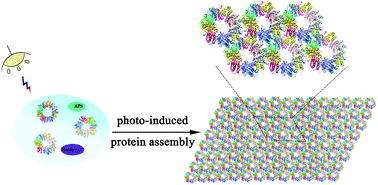当前位置:
X-MOL 学术
›
J. Mater. Chem. B
›
论文详情
Our official English website, www.x-mol.net, welcomes your feedback! (Note: you will need to create a separate account there.)
Photocontrolled protein assembly for constructing programmed two-dimensional nanomaterials†
Journal of Materials Chemistry B ( IF 7 ) Pub Date : 2017-11-28 00:00:00 , DOI: 10.1039/c7tb02826a Linlu Zhao 1, 2, 3, 4, 5 , Yijia Li 1, 2, 3, 4, 5 , Tingting Wang 1, 2, 3, 4, 5 , Shanpeng Qiao 1, 2, 3, 4, 5 , Xiumei Li 1, 2, 3, 4, 5 , Ruidi Wang 1, 2, 3, 4, 5 , Quan Luo 1, 2, 3, 4, 5 , Chunxi Hou 1, 2, 3, 4, 5 , Jiayun Xu 1, 2, 3, 4, 5 , Junqiu Liu 1, 2, 3, 4, 5
Journal of Materials Chemistry B ( IF 7 ) Pub Date : 2017-11-28 00:00:00 , DOI: 10.1039/c7tb02826a Linlu Zhao 1, 2, 3, 4, 5 , Yijia Li 1, 2, 3, 4, 5 , Tingting Wang 1, 2, 3, 4, 5 , Shanpeng Qiao 1, 2, 3, 4, 5 , Xiumei Li 1, 2, 3, 4, 5 , Ruidi Wang 1, 2, 3, 4, 5 , Quan Luo 1, 2, 3, 4, 5 , Chunxi Hou 1, 2, 3, 4, 5 , Jiayun Xu 1, 2, 3, 4, 5 , Junqiu Liu 1, 2, 3, 4, 5
Affiliation

|
Precise self-assembly of proteins with structural heterogeneity, flexibility, and complexity into programmed arrays to mimic the exquisite architectures created by Nature is a great challenge for the development of protein-based functional nanomaterials. Herein, we present a strategy that integrates light stimuli and covalent coupling to prepare size-tunable two-dimensional (2D) protein nanostructures by remote photocontrol. Using Ru(bpy)32+ as a photosensitizer, stable protein one (SP1) was redesigned and self-assembled into nanosheets in the presence of ammonium persulfate (APS) through a rapid and efficient oxidative protein crosslinking reaction. In the design, only a serine-to-tyrosine mutation at position 98 was introduced into SP1 by combining computer simulation and genetic engineering for specific covalent coupling under white light illumination. The chemical and topographical specificities of the photosensitized crosslinking reaction allow control of the direction of protein assembly to form extended 2D nanosheets, which are packed in an orderly manner along the lateral surface of ring-shaped SP1S98Y. Notably, the growth of SP1 nanosheets exhibited isotropical characteristics and can be dynamically mediated by illumination time to achieve precise control of the size of the assembled architectures. The subsequent heat treatment further revealed the excellent thermostability of the 2D periodic SP1 nanostructures, which may find promising applications in the fabrication of various nanobiomaterials after functionalization. The present work demonstrates that the visible light-triggered crosslinking strategy is a facile and environmentally friendly method for constructing advanced protein architectures through hierarchical self-assembly.
中文翻译:

用于构建程序化二维纳米材料的光控蛋白质组装体†
将具有结构异质性,灵活性和复杂性的蛋白质精确自组装成程序化阵列,以模仿Nature创造的精致架构,对于基于蛋白质的功能纳米材料的开发是一个巨大的挑战。在这里,我们提出了一种战略,整合光刺激和共价耦合,以通过远程光控制备尺寸可调的二维(2D)蛋白质纳米结构。使用Ru(bpy)3 2+作为一种光敏剂,经过快速高效的氧化性蛋白质交联反应,在过硫酸铵(APS)的存在下,重新设计了稳定的蛋白1(SP1)并自组装为纳米片。在设计中,通过将计算机模拟和基因工程相结合,仅在白色光照射下将特定的共价偶联引入SP1中,仅将98位的丝氨酸变为酪氨酸突变。光敏交联反应的化学和形貌特异性允许控制蛋白质组装的方向,以形成延伸的2D纳米片,该纳米片沿着环形SP1S98Y的侧面以有序的方式堆积。尤其,SP1纳米片的生长表现出各向同性的特性,并且可以通过光照时间动态地介导,从而实现对组装结构尺寸的精确控制。随后的热处理进一步揭示了二维周期性SP1纳米结构的出色热稳定性,这可能在功能化后的各种纳米生物材料的制造中找到有希望的应用。本工作表明,可见光触发的交联策略是一种通过分层自组装构建高级蛋白质体系结构的简便且环境友好的方法。在功能化之后,其在各种纳米生物材料的制造中可能会找到有希望的应用。本工作表明,可见光触发的交联策略是一种通过分层自组装构建高级蛋白质体系结构的简便且环境友好的方法。在功能化之后,其在各种纳米生物材料的制造中可能会找到有希望的应用。目前的工作表明可见光触发的交联策略是一种通过分级自组装构建高级蛋白质体系结构的简便且环境友好的方法。
更新日期:2017-11-28
中文翻译:

用于构建程序化二维纳米材料的光控蛋白质组装体†
将具有结构异质性,灵活性和复杂性的蛋白质精确自组装成程序化阵列,以模仿Nature创造的精致架构,对于基于蛋白质的功能纳米材料的开发是一个巨大的挑战。在这里,我们提出了一种战略,整合光刺激和共价耦合,以通过远程光控制备尺寸可调的二维(2D)蛋白质纳米结构。使用Ru(bpy)3 2+作为一种光敏剂,经过快速高效的氧化性蛋白质交联反应,在过硫酸铵(APS)的存在下,重新设计了稳定的蛋白1(SP1)并自组装为纳米片。在设计中,通过将计算机模拟和基因工程相结合,仅在白色光照射下将特定的共价偶联引入SP1中,仅将98位的丝氨酸变为酪氨酸突变。光敏交联反应的化学和形貌特异性允许控制蛋白质组装的方向,以形成延伸的2D纳米片,该纳米片沿着环形SP1S98Y的侧面以有序的方式堆积。尤其,SP1纳米片的生长表现出各向同性的特性,并且可以通过光照时间动态地介导,从而实现对组装结构尺寸的精确控制。随后的热处理进一步揭示了二维周期性SP1纳米结构的出色热稳定性,这可能在功能化后的各种纳米生物材料的制造中找到有希望的应用。本工作表明,可见光触发的交联策略是一种通过分层自组装构建高级蛋白质体系结构的简便且环境友好的方法。在功能化之后,其在各种纳米生物材料的制造中可能会找到有希望的应用。本工作表明,可见光触发的交联策略是一种通过分层自组装构建高级蛋白质体系结构的简便且环境友好的方法。在功能化之后,其在各种纳米生物材料的制造中可能会找到有希望的应用。目前的工作表明可见光触发的交联策略是一种通过分级自组装构建高级蛋白质体系结构的简便且环境友好的方法。



























 京公网安备 11010802027423号
京公网安备 11010802027423号